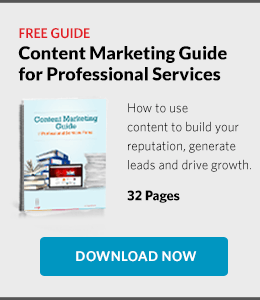Content marketing is red-hot. Not because it's a passing fad, but because it works. In Hubspot's recent State of Inbound marketing report, 41 percent of marketers confirmed content marketing's positive ROI. Like other marketers, you know that content marketing can add real value to your firm's marketing efforts, but your C-suite is still not convinced content marketing is “worth it.”
So how do you get your C-suite to buy in?
Executives are all about the data and cold hard facts. If you can't quantify the value of content marketing, they won't see it as a worthwhile investment. So use the data (and some of your own analysis) to show them how content marketing is positively impacting your firm.
Consider holding a regular meeting — at least monthly — with partners or executives to cover the data you've collected and to regularly remind them that content marketing affects your bottom line — and that you can prove it.
So, what are some of these metrics that you can bring to your team?
Show Them the Website Traffic
In our own experience, we’ve seen a high correlation between website traffic and firm revenue. Intuitively, this isn’t a surprise.
When visitors come to your website, they’re likely engaging with your educational content and learning more about your services, expertise, and past successes. If they find the information they’re looking for and like what they see, you’ll become a trusted source and they’ll come back time and time again.

And when they’re in the market for the services you provide? You’ll be top of mind.
Start by showing your C-suite how a high performance website combined with content marketing can increase firm revenue. Presenting website traffic metrics, especially after implementing content marketing efforts, will show how the traffic (and the content marketing and promotion that is driving that traffic) will help lead to increases in revenue.
SEE ALSO: 4 Metrics to Track ROI in B2B Online Marketing
Include a breakdown on where that traffic is coming from and where the traffic is going to. Are more people coming to your services pages? To your blog? This can indicate what information visitors are most interested in, helping to inform what pages or types of content you should focus on.
Increases in web traffic can directly correlate to increases in revenue. However, because there is often a lag between an increase in web traffic and revenue growth, it's important that you review the numbers with the C-suite regularly, so they can see how increases in traffic are increasing revenue over time.
Track and Report on Conversions
Conversion tracking helps your firm measure your content marketing return on investment by tracking the actions users take after viewing or engaging with your website and social media content.
Using Google Analytics or another analytics tracking system, you can show your C-suite exactly how many conversions your organization is getting each month. Although the definition of “conversions” can vary from firm to firm, we generally think about it in terms of how many people have provided their contact information in exchange for something valuable.
This could be a Contact Us or RFP form that they’ve filled out, or could be when someone downloads a guide, book, research report, or other piece of gated content. In other words, it’s a measure of how much our contact list is growing. This growth means more prospective clients to nurture.
Showing the C-suite how many new contacts you have each month is another proof point of content marketing's value. As a long-tail strategy, you can track prospects along the buying cycle and eventually even show how many of those contacts converted into opportunities and then paying clients.
A/B Test Results
Finally, show that you are continually refining and improving your tactics. A/B testing, also called split testing, allows you to study visitors’ behaviors by testing how prospects interact with your website and react to different versions of content.
Test, test, test. Repeat, repeat, repeat. Today, there are a number of tools out there that make running tests on your website simple and most email marketing software have testing capabilities as well. Testing will always pay off, so never stop doing it.
It should be an integral part of your content marketing strategy and an effective way to show the C-suite that you are engaged in getting the absolute highest ROI possible from your content marketing efforts.
What should you test? Almost everything. Test your landing pages to improve your conversion rates. Test email subject lines to see what is grabbing your audience's attention. Test your website content to see what content or headline visitors are more likely to click on or whether your content is too short or too long.
If the C-suite is still not convinced, dig deeper. Look at your CMS and see what marketing initiatives captured prospects attention before becoming a client. Are there any trends? Did they download a few pieces of content? Open five emails? Whatever the data is, be sure to collect it, analyze it, and most importantly, show it to your executives.
Additional Resources
- Download Hinge’s Content Marketing Guide for Professional Services Firms for tips on creating content that builds credibility, demonstrates expertise and delivers results.
- Get a copy of our Online Marketing for Professional Services book to learn techniques that will generate more leads and increase awareness of your firm.
- Our Lead Generating Website Guide details how your firm can generate qualified leads with its website.
How Hinge Can Help
Content marketing is at the heart of Hinge’s flagship Visible Expert℠ program. It is the leading marketing program for delivering greater visibility, growth, and profits. This customized program will identify the most practical offline and online marketing tools your firm will need to gain new clients and reach new heights.
